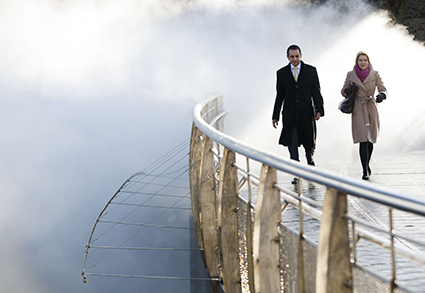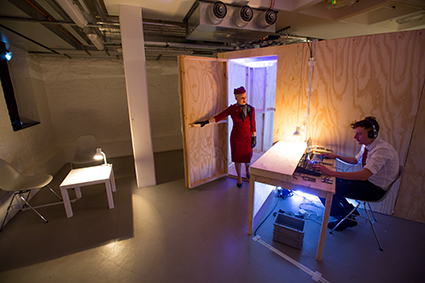Weather: immersive
Tim X Atack

Fog Bridge, Fujiko Nakaya, image courtesy of InBetweenTime Festival, Bristol UK
photo Paul Box
Fog Bridge, Fujiko Nakaya, image courtesy of InBetweenTime Festival, Bristol UK
Outside Arnolfini on Bristol’s harbourside there’s a footbridge over the water to the quay opposite, its span marked halfway across by two large gramophone-like horns turned upwards to the sky. Three times an hour during the InBetweenTime (IBT) Festival the bridge is shrouded in mist, fine droplets of pressurised water, from an installation by the Japanese artist Fujiko Nakaya.
Fujiko Nakaya, Fog Bridge
Each time the haze appears its form and reach alters, twisting and dissipating on the quay’s incoming wind. Sometimes the pedestrian traffic is lost within it, silhouettes and ghosts. Other times the cloud is instantly lifted and forms a kind of crown around the gramophone horns. The piece is called—what else?—Fog Bridge. It’s a simple proposition and pedestrians using the bridge react in many different ways. For a moment you might be in an urban cloud forest, enveloped, lost. You might think about changing global weather or your place in the planet’s ecology. After dark, under the streetlights, those old enough to remember could recall the London smog. Or you could just get pissed off that your clothes are getting slightly wet.
But Fog Bridge does feel modern, in its wry, open invitation—best experienced without justification, its meanings owned by those who stumble upon it. And despite the seriousness of the themes at its heart (climate change, human beings vs nature) it’s a very gentle, comfortable experience—something it shares with a large swathe of work at this year’s IBT festival.
Forced Entertainment, The Notebook
The two principle exceptions to this trend were The Notebook by Forced Entertainment and Extraordinary Rendition by Action Hero. The Notebook is a kind of marathon for its seated audience, with a pain barrier that needs to be broken and euphoric rewards should you stay the course. It’s rare for this Sheffield-based company to adapt a text rather than generate their own (they’ve only done so once before in 2009, with Exquisite Pain, a production of Sophie Calle’s diary of heartbreak) and their approach is minimal, the staging and delivery so carefully constructed you’re unsure whether they’ve done anything at all.
The source material this time is a short novel by Hungarian author Ágota Kristóf, a tale of twin brothers evacuated to a central European farmstead during World War II, surrounded by a supporting cast of craven adults. It’s funny, bleak, unsettling and violent, the story of two outsiders who employ extreme coping mechanisms in the face of an uncaring opportunistic world. Performers Robin Arthur and Richard Lowdon read from the titular notebook—a very visible indicator of where we are in the story, beginning to end—and their delivery is inspired by the twins’ own ascetic view of the world: accounts of their lives must simply be accurate, without illumination or comment, and each boy is accountable only to the other. When the twins speak to another party, they always do so in unison—Lowdon’s and Arthur’s voices merging into one, inflections in absolute sync, cadences locked—and the most that ever happens on stage is the moving of a chair, or a fractional dimming of the lights.
If it sounds relentless, it is: but the story never stands still, a string of troubling encounters, dodgy alliances and catastrophes, and after perhaps half an hour of the performers’ sparse delivery a strange thing happens, and you develop a resonance with the twins—reading in between the lines of their diary, finding their intransigence and inhumanity completely moving. After a further 90 minutes, as your arse numbs and your eyes drift to the books in Lowdon’s and Arthur’s hands, wondering if they end, you nevertheless experience moments of simultaneous confusion and immersion, uncertain which way is morally up or down. And then finally the notebook shuts, and you remember where the hell you are.

Extraordinary Rendition, Action Here, image courtesy of InBetweenTime Festival, Bristol UK
photo Paul Blakemore
Extraordinary Rendition, Action Here, image courtesy of InBetweenTime Festival, Bristol UK
Action Hero, Extraordinary Rendition
Action Hero’s Extraordinary Rendition is not so much an experience as a process. Its main trope is a marriage of the language of consumer aviation—the airport, the attendants, the in-flight entertainment—with the shady world of extrajudicial transfer and torture by proxy, the politically expedient practice of shipping criminal suspects to countries where they can be interrogated by harmful means. You are the sole audient in Extraordinary Rendition, travelling alone, and it’s heavily implied that you’re the potential victim too, a random body in transit towards doom. Again this is carefully and minimally done, never spelled out: the look on the stewardess’ face, the removal of your personal artifacts, phone calls you cannot hear, the constant, threatening (and astonishingly convincing) roar of jet engines. More I won’t say, in case you’re ‘lucky’ enough to be processed yourself when this piece undoubtedly tours.
But while The Notebook is most effective in the immediate moment, Extraordinary Rendition works best long after you’ve walked away unscathed, popping into your head when prompted by news items or Hollywood fictions alike. It makes you realise that for a few moments you might have experienced a mild kind of identity crisis, and it leaves you grateful for the freedoms you take for granted.
Jo Hellier
Returning to the changeable British weather, Jo Hellier’s Flood Plans is a tone poem about water and erosion—embodied by Hellier, fellow performer and sound designer Yas Clarke, plus some extreme noise. Once more at IBT simplicity invites contemplation, making a huge, overwhelming score of the sounds of landscape and weather, played out in darkness. Field recordings of flowing rivers become an industrial monstrosity, rain grows louder and louder until it screams like a city on fire. Then, in an A/B pattern that becomes pleasingly predictable, it repeatedly cuts to silence and light, revealing everyday fragile human bodies on a blank stage. Hellier and Clarke converse in quiet tones then wrestle each other, like waves against bare rock, neither willing to relent, landing in positions both comic and tragic. Then the noise strikes up once more. In the implacable light and monumental dark, Flood Plans somehow makes me think in black and white—conjuring up Ansel Adams’ photography, the land as a body.
In Between Time festival, Fujiko Nakaya, Fog Bridge, Pero’s Bridge; Forced Entertainment, The Notebook, Arnolfini; Action Hero, Extraordinary Rendition, Arnolfini; Jo Hellier, Flood Plans, Arnolfini, Bristol, UK, 12-15
RealTime issue #126 April-May 2015 pg. 16






